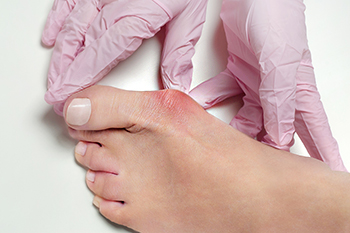
A bunion starts out as a small bony protrusion, and can become a deformity if not promptly treated. It is a progressive disorder, and can occur from wearing shoes that do not fit properly. Genetics is another reason why some people may get bunions, and frequently performing foot stretches may diminish the discomfort. Additionally, these exercises and stretches can help to relieve overall foot soreness. There is a muscle that runs from the bottom of the big toe to the forward area of the arch. When this muscle is strengthened, it can help to align the big toe, where the bunion is located. An effective stretch that can accomplish this is done by picking up a napkin with the foot, and the toes will scrunch to grab it. Research has indicated that getting frequent foot massages may help to relax the adductor muscles, which may gradually strengthen the arch. When the foot is rolled on a tennis ball, the plantar fascia may become stronger, and this may positively affect the arch. If you would like more information about the benefits of how stretching the feet can help bunions, please consult with a podiatrist.
If you are suffering from bunions, contact Dr. David Ungar of Personal Foot Care. Our doctor can provide the care you need to keep you pain-free and on your feet.
What Is a Bunion?
A bunion is formed of swollen tissue or an enlargement of boney growth, usually located at the base joint of the toe that connects to the foot. The swelling occurs due to the bones in the big toe shifting inward, which impacts the other toes of the foot. This causes the area around the base of the big toe to become inflamed and painful.
Why Do Bunions Form?
Genetics – Susceptibility to bunions are often hereditary
Stress on the feet – Poorly fitted and uncomfortable footwear that places stress on feet, such as heels, can worsen existing bunions
How Are Bunions Diagnosed?
Podiatrists often perform two tests – blood tests and x-rays – when trying to diagnose bunions, especially in the early stages of development. Blood tests help determine if the foot pain is being caused by something else, such as arthritis, while x-rays provide a clear picture of your bone structure to your provider.
How Are Bunions Treated?
- Refrain from wearing heels or similar shoes that cause discomfort
- Select wider shoes that can provide more comfort and reduce pain
- Anti-inflammatory and pain management drugs
- Orthotics or foot inserts
- Surgery
If you have any questions, please feel free to contact our office located in Farmington, MI . We offer the newest diagnostic and treatment technologies for all your foot care needs.

